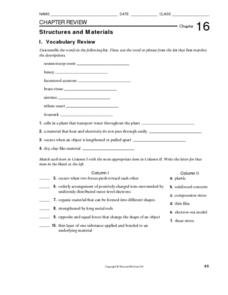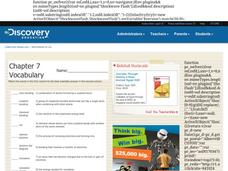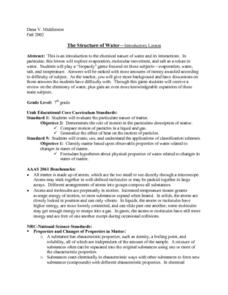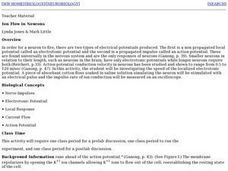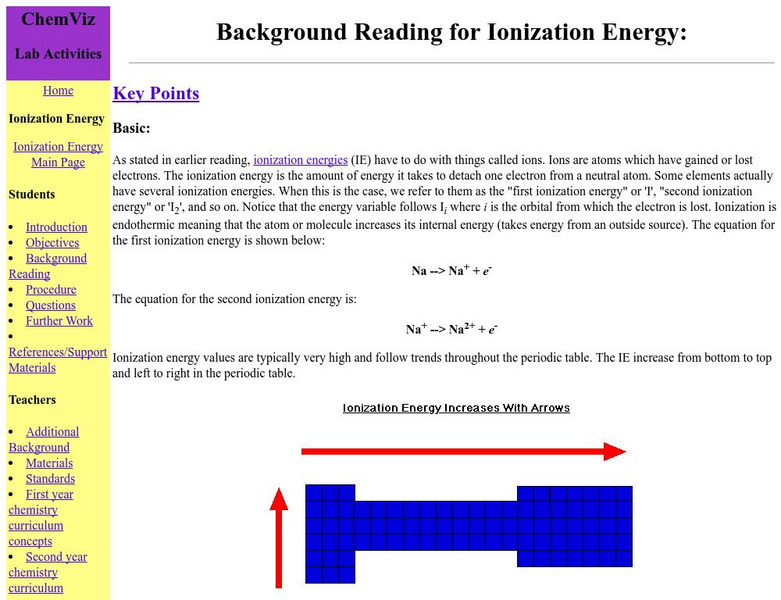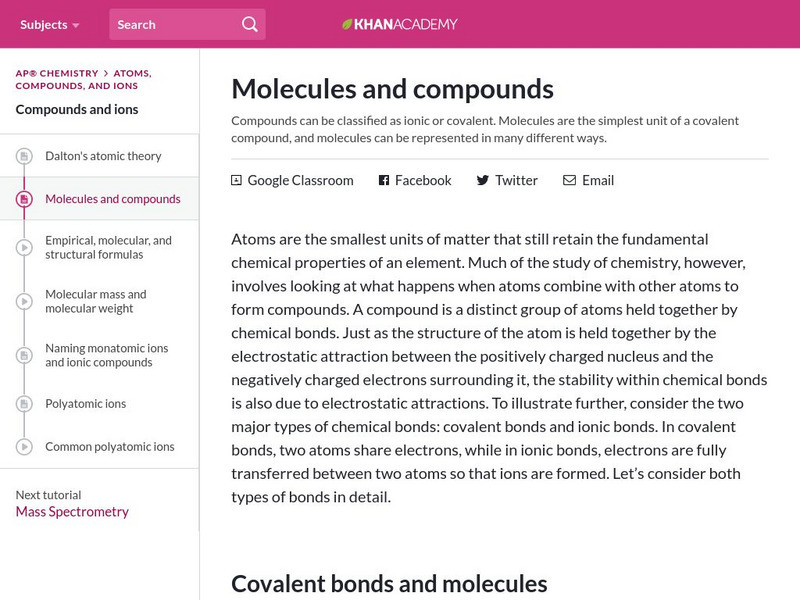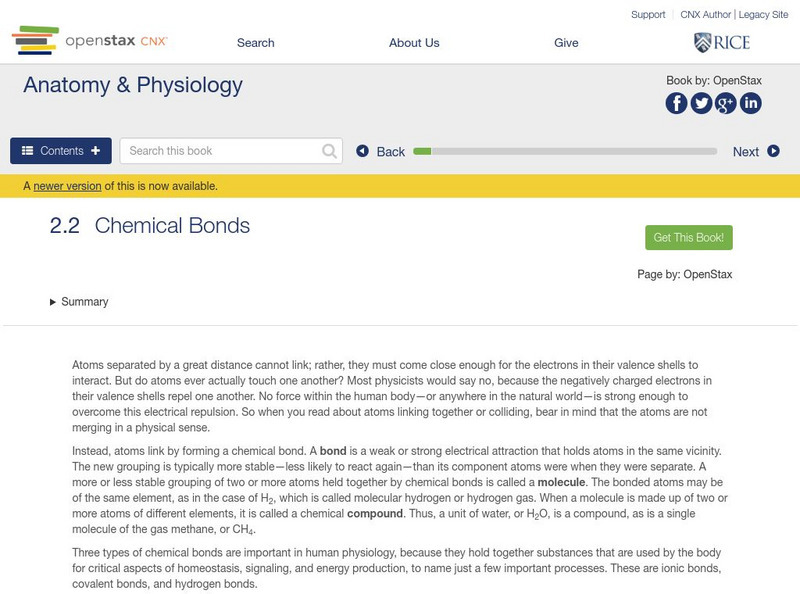Curated OER
Structures and Materials
In this materials activity, students will review different types of materials and the structures that can be made using these materials. This activity has 7 fill in the blank, 6 matching, 1 short answer, and 6 multiple choice questions.
Curated OER
Acids and Bases
In this acids and bases instructional activity, students will identify the molecules represented in a diagram equation and determine if an acidic or basic solution has been produced. Students will list the properties of acidic and basic...
Curated OER
Bond with a Classmate
In this bonding worksheet, students record information about a selected ion in a data table, partner up with an ion of opposite charge and create a new compound, then complete 4 short answer analysis questions and write a brief...
Curated OER
Lewis Structures
In this Lewis structures worksheet, students identify and describe what Lewis structures or dot diagrams are and how they illustrate the valence electrons in an outer shell. Then they use a periodic table to determine the numbers of...
Curated OER
Chapter 7 Vocabulary
In this online vocabulary learning exercise, students match 14 definitions to the correct vocabulary term. Students may click the solution button to check answers.
Curated OER
Chemical Formulas and Naming
Students practice naming and writing formulas for simple chemicals. After a review of vocabulary, they create ion flash cards and discuss the rules for writing chemical compounds. They practice naming and writing the formulas based on...
Curated OER
The Chemical Nature of Water
Seventh graders simulate a Jeopardy game to examine the chemical nature of water. Among the topics featured are evaporation, water, salt, and temperature. finally, as review, 7th graders answer a battery of questions presented by the...
Curated OER
Making Blood!
students research blood's components, and use their math skills to recreate a model of whole blood using commonly found food items.
Curated OER
Ions in the Environment
Learners explain the importance of the five main biogeochemical cycles. In this chemistry instructional activity, students discuss how ions are transported in the environment. They design an experiment to collect data on eutrophication.
Curated OER
Basic Chemistry Review
Students experiment to show their knowledge of molecules and atomic structures. In this chemistry review lesson students participate in an activity and then fill out a worksheet.
Curated OER
Oxidation Numbers
In this oxidation numbers worksheet, students compare metals and nonmetals, draw Lewis Dot Diagrams, and determine the oxidation number for the given elements. This worksheet has 1 multiple choice, 5 short answer, and 12 fill in the...
Curated OER
Combination of Atoms
In this atoms worksheet, students review protons, neutrons, electrons, molecules, compounds, and ions. This worksheet has 10 fill in the blank and 3 problems to solve.
Curated OER
Ions
In this ion structure worksheet, students complete a table for ions using the notations provided. They must identify and complete the atomic number, mass number, number of protons, number of neutrons, and the number of electrons for each...
Curated OER
Testing for Conductivity
Students test the conductivity of selected liquids and solids. They test the circuit by touching the two free ends of the wires together and add salt little by little recording the data after each addition. Finally, students predict...
Curated OER
Life in Extreme Environments - Lakes Under Ice
Students collect chemical, physical, and biological data from a local lake throughout the year. In addition, students discuss the design of an experimental structure for water collection at several specific depths as well as assess the...
Curated OER
Structure of the Atom
Young scholars practice drawing the atomic structure of several different elements. They complete critical thinking questions about atomic structure and compare the atomic mass units for different ions and isotopes of an element.
Curated OER
Ion Flow in Neurons
Student perform an experiment in which they determine the velocity of ion flow in an electrotonic potential and compare it to the velocity of action potentials. They record and analyze their results.
Curated OER
Micro-Magic With Sticky Ions
High schoolers view a video about the formation of precipitates. They complete a worksheet that asks them to identify what makes a compound form and what holds it together.
Curated OER
Aurora Borealis
Young scholars discuss what causes the northern lights and the folklore attached to them. They discuss magnetic fields, and use various common materials to discover if ions conduct electricity.
Shodor Education Foundation
Shodor: Background Reading for Ionization Energy
A very complete lesson on ionization energy, including tables and charts to illustrate the ideas presented in the text.
CK-12 Foundation
Ck 12: Nerve Impulses
[Free Registration/Login may be required to access all resource tools.] In this online tutorial students will explain how nerve impulses are transmitted.
CK-12 Foundation
Ck 12: Trends in the Periodic Table
[Free Registration/Login may be required to access all resource tools.] Students investigate specific properties that can be predicted by an element's position on the periodic table. Additionally, they will look at the formation of ions,...
Khan Academy
Khan Academy: Molecules and Compounds
Article defines and explains compounds which are either ionic or covalent and molecules which are the simplest unit of a covalent compound. Molecules can be represented in many different ways.
OpenStax
Open Stax: Chemical Bonds
Learn here about chemical bonds, a weak or strong electrical attraction that holds atoms in the same vicinity.


